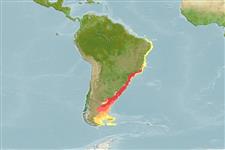Environment: milieu / climate zone / depth range / distribution range
Ökologie
seewasser benthopelagisch; tiefenbereich 15 - 135 m (Ref. 27363). Subtropical
Southwest Atlantic: Espírito Santo, Brazil (Ref. 57756) to northern Argentina.
Length at first maturity / Size / Gewicht / Alter
Maturity: Lm 14.1 range ? - ? cm
Max length : 19.5 cm TL Männchen/unbestimmt; (Ref. 116029)
Rückenflossenstacheln (insgesamt): 10; Rückenflossenweichstrahlen (insgesamt): 13; Afterflossenstacheln 3; Afterflossenweichstrahlen: 7. Third spine of dorsal fin filamentous. Body light brownish dorsally, silvery ventrally. Two dark purplish broad bands on body; anterior band running from anterior part of spinous dorsal base to belly, posterior band from anterior part of soft dorsal base to posterior anal fin base. Two indistinct broad bands present posteriorly on head and caudal peduncle. Each fin pale brownish; tips of pelvic and anal fins and lower part of caudal fin slightly blackish (Ref. 27363).
Life cycle and mating behavior
Geschlechtsreife | Fortpflanzung | Ablaichen | Eier | Fecundity | Larven
Figueiredo, J.L. and N.A. Menezes, 1980. Manual de peixes marinhos do sudeste do Brasil. III. Teleostei (2). Museu de Zoologia, Universidade de São Paulo. Brasil. 90 p. (Ref. 9050)
IUCN Rote Liste Status (Ref. 130435)
Bedrohung für Menschen
Harmless
Nutzung durch Menschen
Fischereien: nicht kommerziell
Mehr Information
ReferenzenAquakulturAquakultur ProfilZuchtlinienGenetikElectrophoresesVererbbarkeitKrankheitenVerarbeitungNutrientsMass conversion
PartnerBilderStamps, Coins Misc.LauteCiguateraGeschwindigkeitSchwimmstilKiemenoberflächeOtolithsGehirngrößeSehfähigkeit
Tools
Zusatzinformationen
Download XML
Internet Quellen
Estimates based on models
Preferred temperature (Ref.
123201): 7.5 - 21.7, mean 13.2 °C (based on 137 cells).
Phylogenetic diversity index (Ref.
82804): PD
50 = 1.0000 [Uniqueness, from 0.5 = low to 2.0 = high].
Bayesian length-weight: a=0.01072 (0.00892 - 0.01288), b=3.07 (3.02 - 3.12), in cm total length, based on LWR estimates for this species (Ref.
93245).
Trophic level (Ref.
69278): 3.7 ±0.5 se; based on size and trophs of closest relatives
Generation time: 3.3 ( na - na) years. Estimated as median ln(3)/K based on 2
growth studies.
Widerstandsfähigkeit (Ref.
120179): hoch, Verdopplung der Population dauert weniger als 15 Monate. (Preliminary K or Fecundity.).
Fishing Vulnerability (Ref.
59153): Low vulnerability (22 of 100).
Nutrients (Ref.
124155): Calcium = 95.1 [33.5, 203.5] mg/100g; Iron = 0.949 [0.468, 1.873] mg/100g; Protein = 17.8 [16.0, 19.6] %; Omega3 = 0.461 [0.256, 0.823] g/100g; Selenium = 27.1 [13.2, 56.2] μg/100g; VitaminA = 29.1 [8.4, 112.8] μg/100g; Zinc = 0.908 [0.605, 1.386] mg/100g (wet weight);
